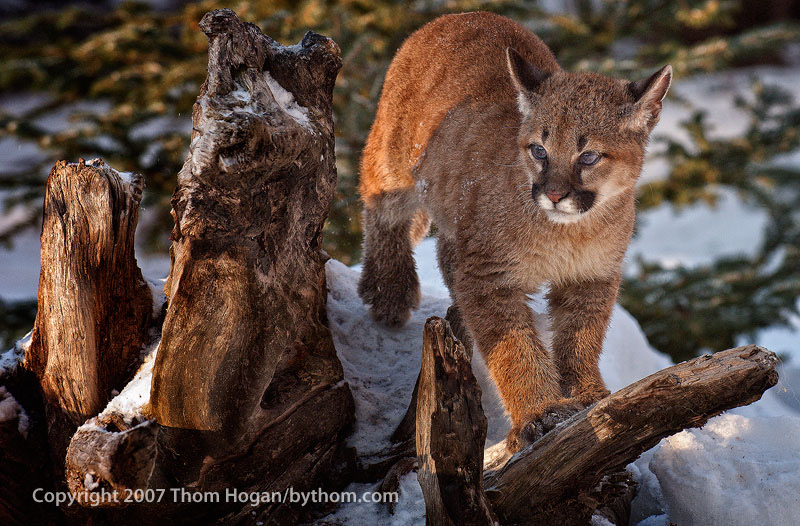
D2x NEF, 70-200mm
One of the dirty secrets of many pro photographers is that sometimes they photograph like amateur photographers. This image is a crop. Why? Because of the autofocus sensor used (center). When you're dealing with subjects that could move every which way, it's difficult to prioritize to a single off-center autofocus sensor or move from sensor to sensor as the subject moves erratically. Moreover, DSLRs have their best autofocus capability in the central region of the frame.
Taken together, those two things often lead one to use the central autofocus sensor when you can't predict motion. As you can see, my focus is dead on with the eyes here, exactly where it should be. But the eyes aren't in the center of the image you see. I was cheating by using the central autofocus sensor, because I knew that I was going to crop the image (otherwise I'd have a lot of out-of-focus background at the top and extra snow on the right). The trick was to balance two things: keeping my best autofocus sensor—and the one that allowed me to react fastest—on the eyes while considering the framing of the image I thought I'd use.
When the cat stopped momentarily and looked left, I let go of the AF-On button (which was set to be the only focus initiator) and reframed slightly left and low of where I had been framed. I still had to crop, but I had to crop far less than if I had left the autofocus on the shutter release and not reframed after obtaining focus.
Focus is tough. Real tough. You can go back to the way we used to do it (manual focus), which is tough because our viewfinders are suboptimal for verifying focus and it's easy to be off by a little bit and not see it. Or you could just trust the AF system all the time and hope it's focusing on what you want it to (not as likely as you’d think). But the truth of the matter is that "autofocus done right" is a complex dance between you and the camera. I'm constantly on and off the AF-On button (in AF-C with focus removed from the shutter release; called Back Button focus technique). I move sensors when I can predict motion. I dial in a bit more aperture for depth of field when I'm not sure, less aperture for isolation when I am. I'll even completely switch autofocus modes (or Dynamic-area AF size) on the fly in some cases based upon subject size and background clutter. That's at least four controls I'm juggling (all with my right hand on my pro bodies). It takes lots of practice to get that right, which is why when I'm not doing my regular work, I'll often schedule animal or sports practice in my "down time."
Indeed, in Botswana last month I was teaching the AF-On dance to some who were new to the game. It actually is trickier than I've described it. For example, with birds taking off I'll often hit the AF-On button just after pressing the shutter release down. Why? Because when the bird is still on the perch, my focus should still be right for where I left it, but many birds start to turn immediately after getting airborne and I need the autofocus system to start helping me adjust. With big birds, I know what direction they'll take off (into the wind, always), so I can even cheat the AF sensor being used to the side of the direction they're headed. So the sequence is AF-On with the bird perched to get focus, release the AF-On button and perhaps reframe a bit (not too much, as geometry will make the focus plane move from where you want it). Hit the shutter release just as the bird heads off and hit the AF-On button again immediately after with the shutter pressed down for the sequence. That said, I don't take a lot of sequences with high frame rates like that, though I did on this workshop to demonstrate what I'd do to the students if I wanted the sequence. Generally, I'm looking for one moment, not a sequence, and I can hit that moment better with a single shot timed right.
Recent studies (now mostly debunked) say that it takes 10,000 hours to become an expert at something. Don't expect to master your autofocus system in an hour. I just spent nearly three weeks taking thousands of wildlife images. Within a few days I was dialed back in. If I don't repeat that kind of practice regularly, it takes me longer to get re-dialed in.
